Introduction: Let us imagine that we, along with our friends and family members, are practicing our favorite outdoor yoga under the shining sun, warming our skin to get enough amount of Vitamin D3, hearing sweet birds chirping, and a cool, gentle breeze flowing. There is no artificial light, no crowd; we are there, our breath, and the rhythm of nature. That’s the blessing of outdoor yoga, where every inhale connects us to the open sky and every exhale grounds us into the earth beneath our feet. The place may be our open backyard, a nearby park, or a plateau with scenic beauty, which adds a new layer of calm, clarity, and connection.
Here, nature provides more rejuvenation, natural healing power, and a peaceful mind. Here, we can practice vigorously our yoga poses with the rhythm of nature. And the best part is, here we don’t need any fancy equipment or a perfect setting. Just let us roll out our Yoga Mat in the fresh air with a strong will to show up.
In this article, we will delve into why more and more people are choosing outdoor yoga, the unique benefits, how to get started, and tips to make outdoor yoga more enjoyable. So, come out with a Yoga Mat with strong determination and let us start our practice.
What is outdoor yoga?
Outdoor Yoga is practicing yoga postures, pranayama, and dhyana in an open atmosphere instead of performing in a Yoga Studio or a Gym. This can be practiced anywhere in parks, courtyards, beaches, and plateaus. The idea of Outdoor Yoga is simple: a combination of the physical and mental benefits of yoga with the healing energy of nature.
While we are practicing outdoor yoga, we can get to breathe fresh air which is pollution-free, get the heat of the sun, and connect ourselves more deeply with the world around us. Outdoor Yoga encourages our mindfulness, reduces stress, and also provides a refreshing change from the indoor environment. Whether we are performing a solo session at morning sunshine or joining a group in a local park, on a beach, or on a hill, this outdoor yoga provides a unique way to deepen our practice and reconnect us with the present moment.
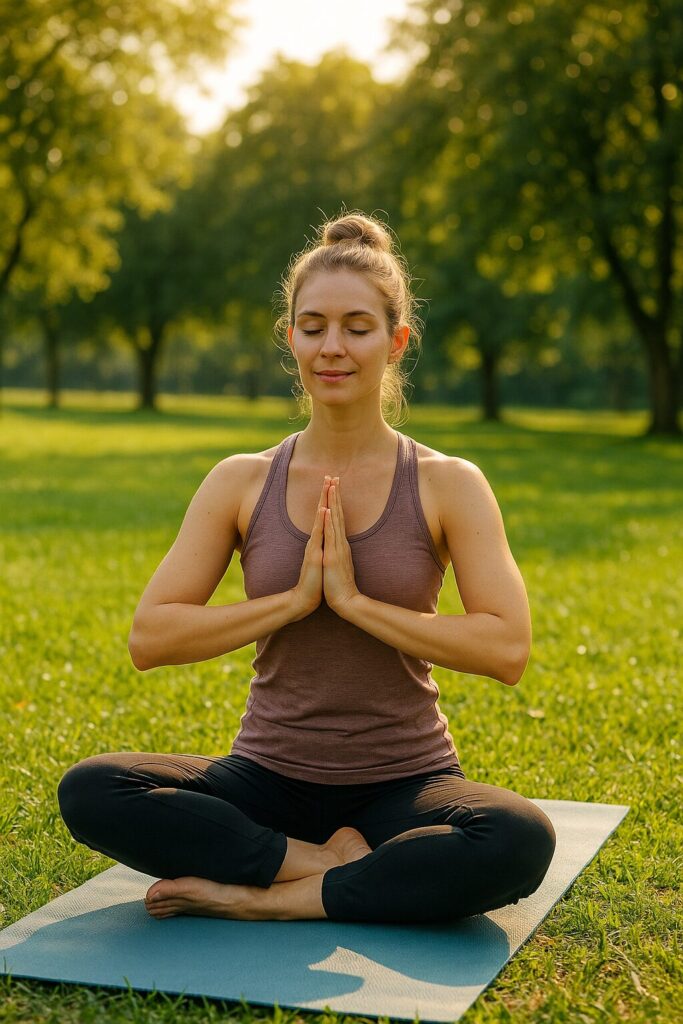
Why are people becoming more and more interested in Outdoor Yoga?
It has been observed, the people of the modern world are getting more and more interested in outdoor yoga, and this has become a popular choice across cities, suburbs, and small towns. But why this shift from indoor to outdoor?
Most of the yoga fanatics may be seasoned ones, or a newcomer is craving a break from indoor environments. The reason is, that people are spending a long time in their offices, in front of a computer or inside a gym, the idea of performing yoga in the fresh air feels like a breath of life. Nature provides a sense of freedom that is hard to find within the four corners of walls. No fluorescent lights. No mirrors. No packed rooms. Just open space and the natural rhythm of the outdoors.
Another reason, that outdoor yoga provides mental health benefits. The studies indicate that being in nature helps to reduce anxiety, boost mood, and improve focus. The calming effects of outdoor yoga provide a powerful duo for managing stress and feeling more grounded. In addition to this, outdoor yoga is accessible to everyone. You don’t require a membership in a club or a fancy studio. You only need a patch of green grass, a yoga mat, and free sunshine. It is inclusive, affordable, and encourages community, especially as more public classes pop up in parks and outdoor spaces.
The Indoor Trap: How modern life keeps us inside:
The modern lifestyle has pulled most people indoors, which we expected. The majority of people became more interested in working remotely, engaging themselves by scrolling through their android phones, streaming entertainment, and endless Zoom meetings, have forced them to stay within the four corners of walls. These people find an occasional break from nature.
The period of the COVID-19 pandemic made it more extreme. During the lockdown period, people were forced to stay inside and compelled to work remotely. While necessary for safety, this shift left a lasting impact. Even after the lockdown was lifted, many people have become prone to work remotely, exercising within a small space of the room, and socializing through screens.
This indoor lifestyle may be convenient, but it throws us into a lack of enriched Vitamin D3 sunshine, too much screen time causing strains in eyes and mind, and sitting for a longer period causes tightening of the muscles of the body and dull mental energy. This created a disconnection not just from nature but also from our friends and relatives.
This is where outdoor yoga comes in to help us to break the cycle, breathe deeply, move freely, and reconnect with the natural world.
What We’re Missing Indoors:
Although staying indoors is more comfortable, but often comes at quite a cost. Most people have become heavily reliant on screens, maybe it is for official work, entertainment, or staying connected. From dusk to dawn, our eyes bounce between phones, laptops, and television screens. Over time, this leads to digital fatigue, poor posture, and physical discomfort.
Staying inside a poorly ventilated space does not provide the same oxygen-rich energy that the outdoor environment provides. Due to this, people may feel sluggish, foggy, or even irritated without knowing the reason.
And then comes artificial lighting. The artificial lighting confuses our internal clock, which regulates our sleep-wake cycle. Due to this, many people experience restless nights or struggle to feel fully awake during the day, even with enough hours to sleep.
This combination of less ventilation and artificial lighting creates a perfect storm of internal energy burnout.
Here, outdoor yoga provides a perfect counterbalance. This outdoor yoga gives our eyes a break, helps us to fill our lungs with enough amount of fresh oxygen and a healthy dose of sunlight. These all help us to keep ourselves active and centered.
Outdoor Yoga Benefits and Drawbacks:
| Aspect | Benefits of Outdoor Yoga | Drawbacks of Outdoor Yoga |
| Environment | Fresh air, natural light, open space | Unpredictable weather (rain, wind, heat, cold) |
| Mental Health | Reduces stress, improves mood, boosts mental clarity | Possible distractions from noise or passersby |
| Physical Health | Natural terrain enhances balance and engages more muscles | Uneven surfaces may pose injury risks for beginners |
| Connection with Nature | Encourages mindfulness and grounding (earthing benefits) | Potential exposure to insects, pollen, or allergens |
| Vitamin D Exposure | Sunlight boosts vitamin D, supports immune function | Risk of sunburn or dehydration if not careful |
| Cost & Accessibility | Free to practice in parks, beaches, and backyards | May require transportation to find a quiet or safe outdoor space |
| Space & Freedom | No crowded studios or time limits—freedom to move and breathe deeply | Lack of structure or routine might reduce consistency for some |
| Social Interaction | Community classes in open spaces can build social connections | Public spaces may feel intimidating for new or shy practitioners |
| Sensory Experience | Sounds, sights, and smells of nature enhance sensory awareness | Overstimulation possible in busy or urban outdoor settings |
The major benefits of outdoor yoga:
There are numerous benefits of Outdoor Yoga. But here we are providing a few important benefits that will not cost you more.
- Boost Mood and reduce stress: Spend only 30 minutes out of your costly 1440 minutes with nature, which will help you to lessen your stress level and improve your mental wellbeing. Combining this with the calming effect of yoga, you will get a powerful natural remedy for anxiety, depression, and burnout, and you will feel refreshed and recharged.
- Improves focus and mindfulness: During the practice of outdoor yoga, our sensory organs become more alert. Here we can notice the sounds of leaves rustling, birds’ chirping, or the feeling of gentle cold wind. These sensory cues help us to stay present and fully engaged in the moment, enhancing our ability to focus and connect with our breath and body.
- Provides Natural Vitamin D: We all know that sunlight is full of Vitamin D. This sunlight helps us to keep our immune system, strengthen our bones, and keep our mood fresh. Practicing outdoor yoga under natural sunlight provides us with a healthy dose that is hard to get inside.
- Strengthen our Balance and Stability: The Outdoor surface is not even compared to the indoor. Our muscles are put through additional trials when we practice on grass, sand, or uneven terrain. It enhances our core strength, balance, and coordination, which makes our practice more dynamic and physically demanding.
- Encourages grounding and connection: Outdoor Yoga helps to connect us with the earth. Barefoot practice of yoga on the natural grass helps to reduce inflammation, improve our sleep pattern, and also provides a feeling of calmness. This worthy connection with nature adds emotional depth to our yoga routine.
- Increases Energy and creativity: Being outdoors exposes us to natural rhythms and light, which may raise our energy and spark fresh ideas. After an outside session as opposed to an inside one, many people report feeling more creative, lively, and mentally clear.
- Cost-free access: In outdoor yoga, we don’t need any gym membership. A park, backyard, beach, or plateau is all we need. It is an affordable, flexible, and beginner-friendly way to stay active and centered.
Best Places to Practice Yoga:
- Parks and nature trails
- Beaches and lakefronts
- Rooftop gardens
- Backyard or Balcony
- Community centers
- Hill stations
Tips for a successful Outdoor Yoga session:
To get the maximum benefits of Outdoor Yoga practice, a little preparation is required. Here are some essential items that will help you:
- Yoga Mat: Choose a durable, non-slip mat that you don’t mind getting a little dirty. If you’re practicing on grass or sand, consider a thicker mat or a yoga towel for extra comfort and support.
- Sunscreen: UV radiation may damage skin even on overcast days. Before starting outdoor yoga, especially if practicing during the hours of most sunshine, try applying a broad-spectrum sunscreen. Remember areas such as your shoulders, neck, and ears.
- Bug Spray: Bugs may distract your attention. A gentle, skin-safe insect repellent will help keep mosquitoes, ants, and other bugs away so we can stay focused on our flow.
- Water Bottle: If you are practicing in the sun, hydration is essential. Therefore, a water bottle is required throughout the Outdoor Yoga session to keep energy high and to avoid dehydration.
- Optional items: A Hat, sunglasses, and a light towel are also required.
Beginner-friendly Yoga Poses for Outdoor Yoga:
Grounding through Nature: The most powerful benefit of Outdoor Yoga is to create a feeling of being with nature. When we are practicing on the earth, due to its uneven nature, we have to anchor tightly with the ground. There are various poses we can practice outdoors:
1. Sun Salutation (Surya Namaskar): Sun Salutation or Surya Namaskar is one of the most powerful yoga postures when it is practiced outdoors. In Sanskrit, the meaning of Surya is Sun, and Namaskar is a salutation. This is generally practiced in the open sky to honor the Sun’s life-giving energy. Therefore, the open sky is the best place to perform Surya Namaskar.
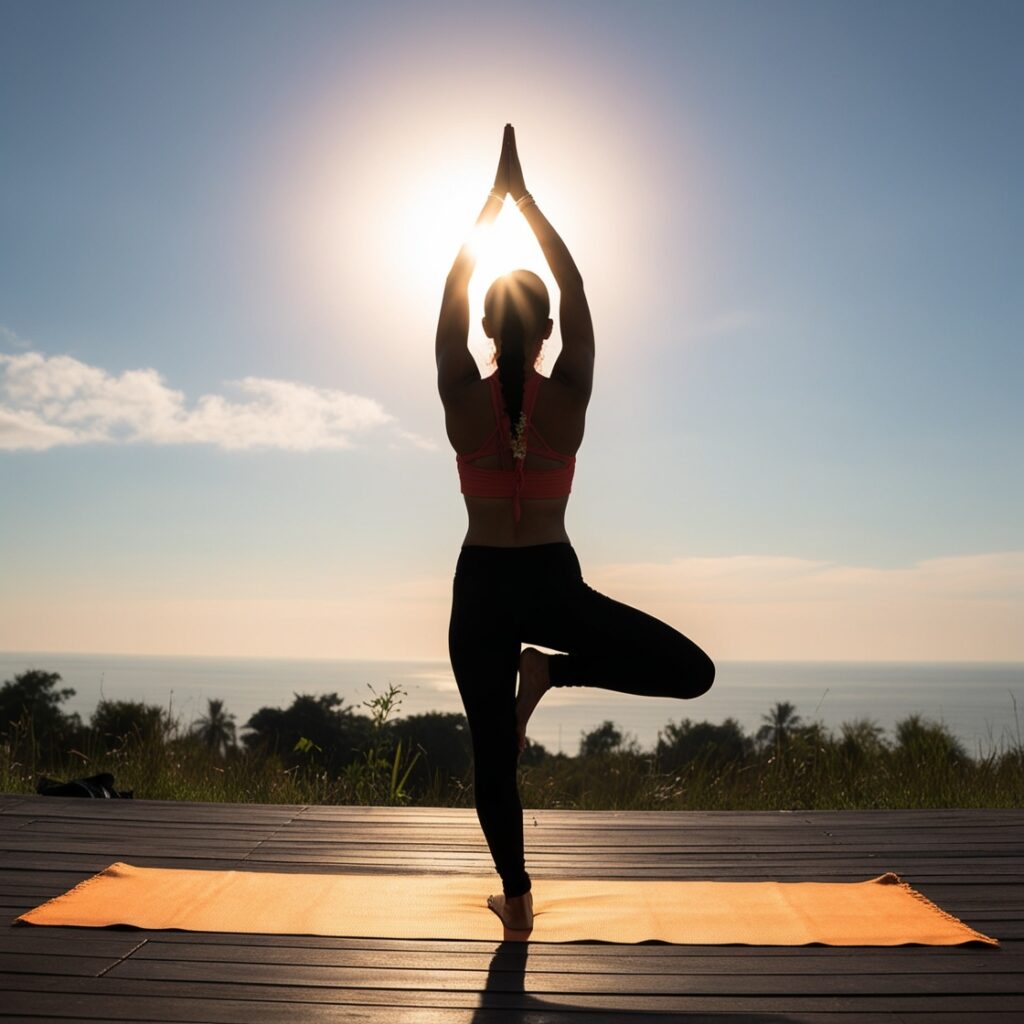
Why is Surya Namaskar perfect for Outdoor Yoga?
There are various benefits to performing Surya Namaskar in the open sky. Some of the important benefits are mentioned below:
- It connects with the Natural Rhythm
- Warms up the body naturally
- Boosts mental clarity and focus
- Enhances the meditative aspect
- Energizing the body
Whether you are a seasoned practitioner or a beginner, starting a few rounds of Surya Namaskar is a great way to warm up the body for creating energy.
2. Tree Pose: This pose is also one of the most beneficial for outdoor yoga. It helps in grounding and balancing on the earth. Standing on the earth with one foot rooted down and the other lifted, you naturally connect with the qualities of a tree: steady, calm, and strong. Practicing this pose in nature helps you feel that connection more deeply.

The benefits are:
- It improves balanced focus
- Enhance mindfulness
- Encourages grounding and stability
- Builds confidence and is ready to act promptly.
3. Eagle Pose or Garudasana: Eagle Pose is also known as Garudasana. It is an important standing balance pose that tests attention, builds muscle, and encourages intense focus. All these advantages are enhanced when you practice it outside. This helps the practitioners to maintain composure and awareness even while everything around you are moving, just like a real eagle. This is how it facilitates outdoor yoga.
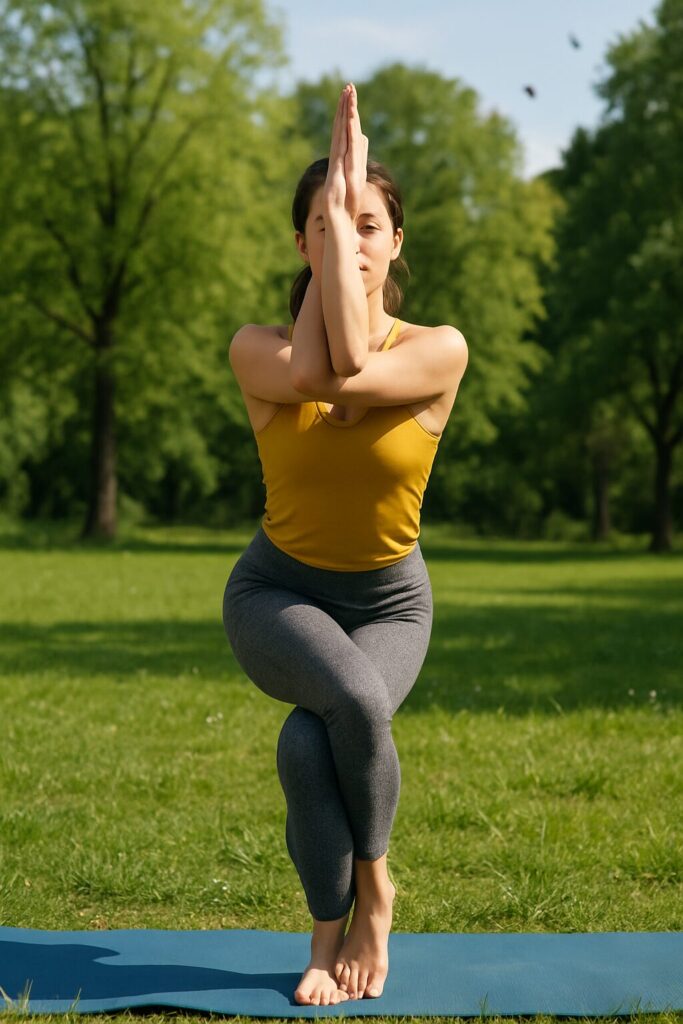
The benefits are:
- Sharpens Balance on Natural Surface
- Boosts mental focus
- Improves circulation and detoxification
- Increases body-mind awareness
- Builds inner strength to fight against diseases
4. Savasana or Corpse Pose: In most yoga practices, the last resting pose is called Savasana, or Corpse Pose. Lying still on your back may seem easy, but it’s actually one of the most crucial aspects of your session. Savasana becomes much more potent and incredibly calming when done outside.
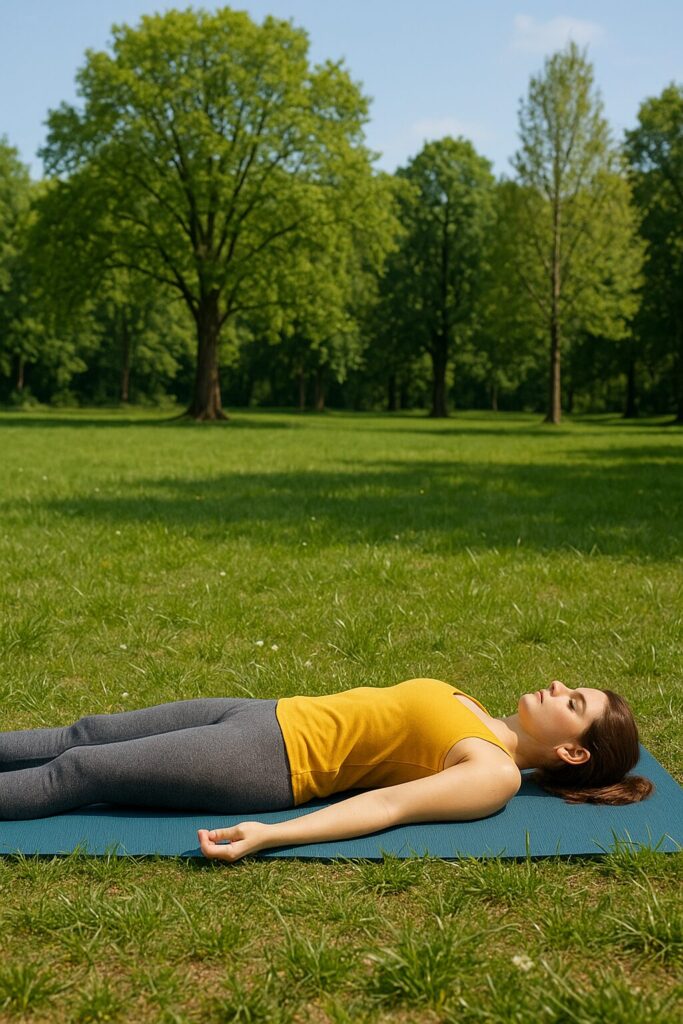
The Benefits are:
- It deepens relaxation after practicing various postures
- Enhances the mind-body connection
- Recharges the internal energy
- Creates closure and stillness.
Why Westerners Are Choosing the Himalayas for Yoga Practice as the best place:
Over a few decades, people from Western Countries have been attracted more and more as a spiritual magnet for learning, practicing, and curing some incurable diseases. I am giving some examples of why this ancient mountain range continues to attract millions of Westerners every year. Some of them stay for a longer period and prefer to stay permanently some of them return after their purpose is served.
- Return to Yoga’s Root: Spiritual vibration of the Himalayas: The Himalayas are regarded as the birthplace of Yoga. For many Western people, those who actually want to learn the inner intricacies of Yoga, flock together to visit this sacred region to avail a chance to know from the original sources and authentic lineages. Learning and practicing Yoga, especially in the towns like Rishikesh, Dharmashala, Ranikhet, Satopanth, Kaushani, and various other areas where many fortunate people may come in contact with various Yogis/ Monks/Sages either in their subtle body or physical body who are living more than 100 years and that too physically fit.
- Spiritual vibration of the Himalayas: The Himalayas have a profound spiritual aura of mystery that is absent from most metropolitan settings. The setting naturally encourages introspection, meditation, self-realization, and getting cured from some incurable diseases because of the peaceful natural surroundings, the stillness, the elevation, and the presence of sages and spiritual instructors, and Ayurveda Acharyas.
- Disconnect from Western Noise: In the West, screens, noise, schedules, and obligations are all common sources of continual stimulation. One may disconnect, calm down, and re-establish a connection with the soul in their lifetime in the Himalayas. For individuals who want to cleanse, heal, or simply take a deeper breath, this tranquilly is quite attractive.
- Authentic Ashram and Teacher experiences: Unlike commercial yoga studios often found in the West, the Himalayas offer access to traditional Ashrams, Gurukuls, and Experienced Teachers who have spent years in disciplined spiritual practice. Many Westerners seek a more immersive, disciplined, and spiritually aligned experience, which is often hard to find elsewhere in the Western World.
- Cultural Curiosity and transformation: For many Western outdoor yoga practitioners, yoga is just not a physical exercise, acrobatic, etc., it is a segment of the spiritual and cultural journey in their life. Traveling to India and studying in the Himalayas allows them to experience yogic philosophy, Sanskrit chanting, Ayurveda, Meditation, and ultimately Self-realization in a way that transforms their understanding and practice of yoga.
- Affordable long-term stay: As compared to the high costs of Yoga retreats or training programs in the West, many Himalayan Yoga Institutes offer long-term stays, yoga teacher training, and retreats at a very low cost. This makes it easier for Westerners to spend a week, a month, or even a year at a nominal cost.
In addition to yoga, the Himalayas appeal to Westerners because of their tranquility, wisdom, spiritual heritage, and opportunity for introspection. The mountains provide a special setting for the fusion of Ancient Yoga culture with contemporary ideas, which can never be ignored.
Conclusion:
Step out with your Yoga Mat– In this busy world and busy work schedule, we spend so much of our time indoors, being glued to the screen, surrounded by artificial light, and caught up in a stressful life. Here, outdoor yoga offers a breath of Fresh Air, bright sunshine enriched with Vitamin D.
There is more to it than a simple change of scenery. It’s a call to get back in touch with your body, the natural world, and yourself. Every breath seems deeper, every moment more alive, whether you’re resting in Savasana under the open sky, holding Tree Pose among the trees, or flowing through Surya Namaskar at daybreak.
A complex setup is not necessary. All you need is your Yoga Mat, some Fresh Air, and the readiness to step outside with awareness.
FAQs:
Question No. 1: Is outdoor Yoga better than Indoor Yoga?
Ans: It depends on the Practitioner’s choice. Both outdoor and indoor yoga have their unique benefits and the better option comes as per your goal, preference, and environment.
Question No. 2: What is the best time for outdoor yoga?
Ans: The best time is early morning between 5.30 AM – 8.00 AM. And in the evening between 5.00 PM – 7.00 PM.
Question No. 3: What should I wear for outdoor yoga?
Ans: When practicing Yoga outside, you should wear lightweight, airy, flexible, and breathable clothes suited for the weather.
Question No. 4: Is it safe to do yoga outdoors?
Ans: Outdoor yoga is generally safe, like any other activity performed outside. Some points are to be kept in mind. If you take proper preparation, it is peaceful, refreshing, and totally safe for every outdoor yoga practitioner.



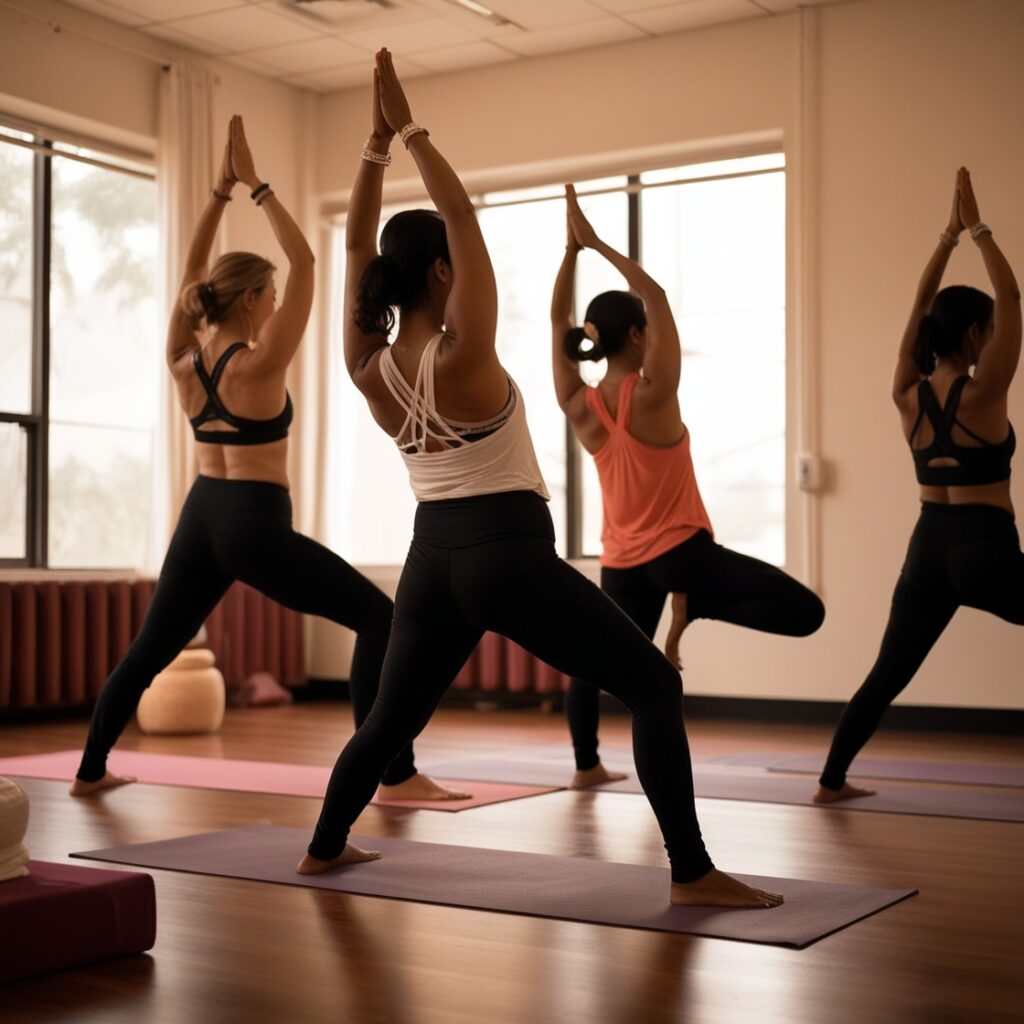



1 thought on “When Mat Meets Earth: Why Outdoor Yoga is the best choice for 2025”